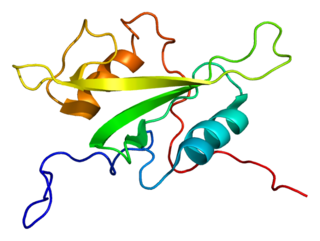
Tyrosine-protein kinase ITK/TSK also known as interleukin-2-inducible T-cell kinase or simply ITK, is a protein that in humans is encoded by the ITK gene. ITK is a member of the TEC family of kinases and is highly expressed in T cells.

The Linker for activation of T cells, also known as linker of activated T cells or LAT, is a protein involved in the T-cell antigen receptor signal transduction pathway which in humans is encoded by the LAT gene. Alternative splicing results in multiple transcript variants encoding different isoforms.

Interferon regulatory factor 5 is a protein that in humans is encoded by the IRF5 gene. The IRF family is a group of transcription factors that are involved in signaling for virus responses in mammals along with regulation of certain cellular functions.

Alpha-taxilin also known as interleukin-14 (IL-14) or high molecular weight B-cell growth factor (HMW-BCGF) is a protein that in humans is encoded by the TXLNA gene.

Serine/threonine-protein kinase D2 or PKD2 is an enzyme that in humans is encoded by the PRKD2 gene.

Breast cancer anti-estrogen resistance protein 3 is a protein that in humans is encoded by the BCAR3 gene.

EGF-containing fibulin-like extracellular matrix protein 2 is a protein that in humans is encoded by the EFEMP2 gene.

Tyrosine-protein kinase TXK is an enzyme that in humans is encoded by the TXK gene.

Mitogen-activated protein kinase kinase kinase kinase 5 is an enzyme that in humans is encoded by the MAP4K5 gene.

Leucine-rich repeats and death domain containing, also known as LRDD or p53-induced protein with a death domain (PIDD), is a protein which in humans is encoded by the LRDD gene.

Regulator of cell cycle RGCC (RGCC) also known as response gene to complement 32 protein (RGC-32) is a protein that in humans is encoded by the RGCC gene.

Uncharacterized methyltransferase WBSCR22 is an enzyme that in humans is encoded by the WBSCR22 gene.

T-cell receptor-associated transmembrane adapter 1 is a protein that in humans is encoded by the TRAT1 gene.

Signal-transducing adaptor protein 2 is a protein that in humans is encoded by the STAP2 gene.

Protein pellino homolog 1 is a protein that in humans is encoded by the PELI1 gene.

NACHT, LRR and PYD domains-containing protein 12 is a protein that in humans is encoded by the NLRP12 gene.

SH3 and PX domain-containing protein 2A is a protein that in humans is encoded by the SH3PXD2A gene.

5-azacytidine-induced protein 2 is a protein that in humans is encoded by the AZI2 gene.

Hermansky–Pudlak syndrome 6 (HPS6), also known as ruby-eye protein homolog (Ru), is a protein that in humans is encoded by the HPS6 gene.

DnaJ homolog subfamily C member 30 (DNAJC30), also known as Williams Beuren syndrome chromosome region 18 protein (WBSCR18), is a protein that in humans is encoded by the DNAJC30 gene. This intronless gene encodes a member of the DNAJ molecular chaperone homology domain-containing protein family. This gene is deleted in Williams syndrome, a multisystem developmental disorder caused by the deletion of contiguous genes at 7q11.23.



















